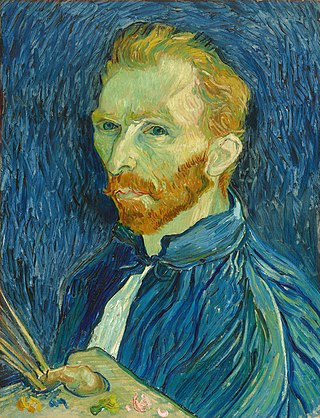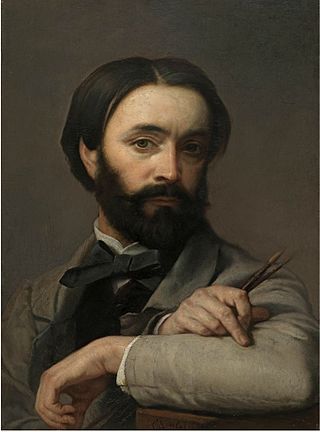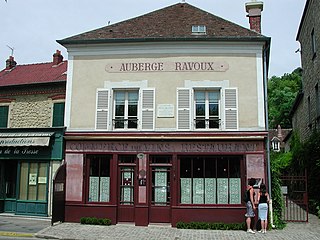
Vincent Willem van Gogh was a Dutch Post-Impressionist painter who is among the most famous and influential figures in the history of Western art. In just over a decade he created approximately 2100 artworks, including around 860 oil paintings, most of them in the last two years of his life. They include landscapes, still lifes, portraits and self-portraits, and are characterised by bold, symbolic colours, and dramatic, impulsive and highly expressive brushwork that contributed to the foundations of modern art. Only one of his paintings was known by name to have been sold during his lifetime. Van Gogh became famous after his suicide at age 37, which followed years of poverty and mental illness.

Lust for Life is a 1956 American biographical film about the life of the Dutch painter Vincent van Gogh, based on the 1934 novel of the same title by Irving Stone which was adapted for the screen by Norman Corwin.

Théophile "Théo" van Rysselberghe was a Belgian neo-impressionist painter, who played a pivotal role in the European art scene at the turn of the twentieth century.

Anthonij "Anton" Rudolf Mauve was a Dutch realist painter who was a leading member of the Hague School. He signed his paintings 'A. Mauve' or with a monogrammed 'A.M.'. A master colorist, he was a very significant early influence on his cousin-in-law Vincent van Gogh.

Lust for Life (1934) is a biographical novel by Irving Stone about the life of the Dutch painter Vincent van Gogh and his hardships. It was Stone's first major publication, and is largely based on the collection of letters between Vincent van Gogh and his younger brother, art dealer Theo van Gogh. This correspondence lays the foundation for most of what is known about the thoughts and beliefs of the artist. Stone conducted a large amount of "on-field" research for the novel, as is mentioned in the afterword.

The Church at Auvers is an oil painting created by Dutch post-impressionist artist Vincent van Gogh in June 1890 which now hangs in the Musée d'Orsay in Paris, France.

The Borinage is an area in the Walloon province of Hainaut in Belgium. The name derives from the coal mines of the region, bores meaning mineshafts. In French the inhabitants of the Borinage are called Borains.
Vincent van Gogh lived during the Impressionist era. With the development of photography, painters and artists turned to conveying the feeling and ideas behind people, places, and things rather than trying to imitate their physical forms. Impressionist artists did this by emphasizing certain hues, using vigorous brushstrokes, and paying attention to highlighting. Vincent van Gogh implemented this ideology to pursue his goal of depicting his own feelings toward and involvement with his subjects. Van Gogh's portraiture focuses on color and brushstrokes to demonstrate their inner qualities and Van Gogh's own relationship with them.

This is a chronology of the artist Vincent van Gogh. It is based as far as possible on Van Gogh's correspondence. However, it has only been possible to construct the chronology by drawing on additional sources. Most of his letters are not dated and it was only in 1973 that a sufficient dating was established by Jan Hulsker, subsequently revised by Ronald Pickvance and marginally corrected by others. Many other relevant dates in the chronology derive from the biographies of his brother Theo, his uncle and godfather Cent, his friends Émile Bernard and Paul Gauguin, and others.

Cuesmes is a sub-municipality of the city of Mons located in the province of Hainaut, Wallonia, Belgium. It was a separate municipality until 1972. On 1 January 1972, it was merged into Mons.

Goupil & Cie is an international auction house and merchant of contemporary art and collectibles. Jean-Baptiste Adophe Goupil founded Goupil & Cie in 1850. Goupil & Cie became a leading art dealership in 19th-century France, with its headquarters in Paris. Step by step, Goupil established a worldwide trade in fine art reproductions of paintings and sculptures, with a network of branches and agents in London and other major art capitals across Continental Europe as well as in New York City and Australia. LesAteliers Photographiques, their workshop north of Paris, in Asnières, was instrumental in their expansion from 1869. The leading figure of Goupil & Cie was Jean-Baptiste Adolphe Goupil (1806–1893). His daughter Marie married the French artist Jean-Léon Gérôme.

Abraham van der Waeyen Pieterszen was a Dutch-born painter, trained in Antwerp. From 1844 Pieterszen worked as a deacon, later as a preacher for the Protestant Union of Belgium in Antwerp, Brussels, Mechelen and Leuven, finally in Horebeke. For 22 years, from 1857 to 1877, Pieterszen served as agent-général of the committee of evangelisation ; from 1860 to 1867 as editor of L'Union, the official paper of the Belgian Protestants, too - but this additional task proved to be too much for him.

Charles Verlat or Karel Verlat was a Belgian painter, watercolorist, engraver (printmaker), art educator and director of the Antwerp Academy. He painted many subjects and was particularly known as an animalier and portrait painter. He also created Orientalist works, genre scenes, including a number of singeries, religious compositions and still lifes.

The Auberge Ravoux is a French historic landmark located in the heart of the village of Auvers-sur-Oise. It is known as the House of Van Gogh because the Dutch painter Vincent van Gogh spent the last 70 days of his life as a lodger at the auberge. During his stay at Auvers, Van Gogh created more than 80 paintings and 64 sketches before shooting himself in the chest on 27 July 1890 and dying two days later on 29 July 1890. The auberge (inn) has been restored as a museum and tourist attraction. The room where Van Gogh lived and died has been restored and can be viewed by the public.

Wheat Fields is a series of dozens of paintings by Dutch Post-Impressionist artist Vincent van Gogh, borne out of his religious studies and sermons, connection to nature, appreciation of manual laborers and desire to provide a means of offering comfort to others. The wheat field works demonstrate his progression as an artist from the drab Wheat Sheaves made in 1885 in the Netherlands to the colorful and dramatic 1888–1890 paintings from Arles, Saint-Rémy and Auvers-sur-Oise in rural France.

Dr. Gachet's Garden in Auvers and Marguerite Gachet in the Garden were both painted in 1890 by Vincent van Gogh in the gardens of his homeopathic physician, Dr. Paul Gachet. Both paintings reside at the Musée d'Orsay.

The earliest known works of Vincent van Gogh comprise a group of paintings and drawings that Vincent van Gogh made when he was 27 and 28, in 1881 and 1882. Over the course of the two-year period Van Gogh lived in several places. He left Brussels, where he had studied for about a year in 1881, to return to his parents’ home in Etten, where he made studies of some of the residents of the town. In January 1882 Van Gogh went to The Hague where he studied with his cousin-in-law Anton Mauve and set up a studio, funded by Mauve. During the ten years of Van Gogh's artistic career from 1881 to 1890 Vincent's brother Theo would be a continuing source of inspiration and financial support; his first financial support began in 1880 funding Vincent while he lived in Brussels.

Peasant Character Studies is a series of works that Vincent van Gogh made between 1881 and 1885.

Ippy and Gertie Posing at Fashion House Hirsch, Amsterdam is a circa 1916 oil on canvas painting by the Dutch artist Isaac Israëls. It depicts the twin sisters Helena (1895-1964) and Geertruida Wehmann (1895-1975), models at the Amsterdam fashion house Hirsch & Cie in the Leidseplein whose professional names were Ippy and Gertie respectively.

Van Gogh House is a cultural site in Nieuw-Amsterdam, in the province of Drenthe in the Netherlands. The painter Vincent van Gogh stayed here for two months in 1883; the house is now a museum.





















